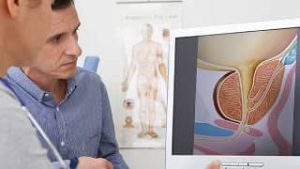Prostatitis - Causes, Symptoms, Diagnosis and Treatment

The prostate is a gland in the size and shape of a chestnut which surrounds the urethra in men. It is located just below the bladder and is an integral part of the male reproductive system.
What are the functions of the prostate ?
It produces a fluid, seminal fluid, which helps to nourish and transport sperm.
The prostate also helps ejaculation or expulsion of semen contracting during orgasm.
The two main periods of growth
The prostate goes through two main periods of growth:
* The first period of growth occurs early in puberty, when the prostate doubles in size.
* The second phase of growth occurs after the age of 60 and is called benign prostatic hyperplasia or BPH. As the prostate becomes greater, the layer of surrounding tissue prevents it from developing, leading to an increase in pressure on the urethra.
What is prostatitis ?
Prostatitis is a term used to describe the infection of the prostate. These infections are typically caused by bacteria, but there is also a form of non-bacterial disease.
There are several risk factors associated with infection of the prostate and the most common are: recent urinary tract infection, history of sexually transmitted diseases such as gonorrhea or chlamydia, smoking and excessive alcohol consumption.
Prostatitis is the most common genitourinary infection in men aged less than 50 years. It is true that this infection is not too severe, however, if it is not treated in time, it can spread to other structures such as the testis and epididymis, and in severe cases, it can destroy the prostate gland.
The symptoms of prostatitis
An inflammation of the prostate can cause a variety of symptoms and the most common ones are the following:
1. Recurrent urinary tract infections
2. Frequent desire (urinary frequency), compelling and urinating
3. Difficult or painful urination (dysuria)
4. Need to urinate during the night
5. Fever and chills
6. Diffused muscle pain
7. Ejaculation pain
8. Blood in the semen
9. Sexual dysfunction
10. Pain in the lower back, pelvis or perineum
Types of prostatitis
There are four types of prostatitis :
1. Acute bacterial prostatitis
This type of prostatitis is relatively easy to diagnose because the symptoms are characteristic.
Men with this disease often have chills, fever and pain in the lower back and genital area. The urge to urinate is common especially during the night. The jet is often weak and sometimes there is a urinary blockage.
The bacteria in question are usually the following: Escherichia coli ( 80% of infections) , Pseudomonas aeruginosa, Serratia marcescens, Klebsiella spp and Proteus mirabilis.
Having a prostate adenoma, undergoing an endoscopic examination of the bladder, having a urinary catheter or unprotected anal sex (without a condom) are all factors risks that contribute to develop acute bacterial prostatitis.
2. Chronic bacterial prostatitis (CBP)
This is a recurrent urinary tract infection in men which is transmitted by a chronic infection of the prostate. In most cases, the symptoms of prostate infection are difficult to detect.
Common symptoms are as those of a simple urinary tract infection, a pain or a burning sensation when urinating.
3. Nonbacterial chronic prostatitis or chronic pelvic pain syndrome
It is currently an inexplicable form of the disease. The symptoms can vary in intensity significantly from mild discomfort to an almost disabling condition. The CPPS may be inflammatory or non-inflammatory infection.
The most likely causes are suggested:
* If you frequently lift heavy objects.
* Some jobs : truck driving or operating heavy machinery.
* Physical activity, excessive exercise (especially cycling).
* Spasms of the pelvic muscles.
* The anatomical abnormalities of the urinary tract.
4. Asymptomatic inflammatory prostatitis
This is a very dangerous form of the disease because there are no symptoms that may indicate an infection and inflammation of the prostate.
There is no pain or discomfort, but there are white blood cells (leukocytes) in prostatic secretions.
Diagnosis of prostatitis
The symptoms are generally sufficient in most cases to form a diagnosis of prostatitis. In the case of acute prostatitis, the urinalysis (urine cytology examination) usually identifies the germ.
But sometimes, prostatitis can be difficult to diagnose, mainly because its signs and symptoms often resemble many other diseases.
DRE is an excellent diagnostic method because the swelling of the prostate can be felt under the finger. Digital rectal examination, however, is in most cases very painful.
Culture fluid from the prostate after prostatic massage can also highlight the microorganisms responsible for the infection. When the prostate is inflamed, the liquid should contain a large number of white blood cells.
If the doctor still has some doubts, he can insert a special instrument called a cystoscope through the penis to directly visualize the prostate from the inside.
In case of recurrent prostatitis, your doctor may decide to perform a urethrography to look for urethral stricture.
The treatment of prostatitis
Drugs
1. Antibiotics
Before the use of antibiotics susceptibility testing is performed. This is to test the bacteria causing the infection after withdrawal from the patient to determine which antibiotic is most appropriate to overcome the disease.
Often, pending the outcome of the DST, the doctor will first prescribe antibiotics to the family of fluoroquinolones (such as Noroxine ® = Norfloxacin, Enoxor ® = ® = Enoxacin and Logiflox Lomefloxacin) which have demonstrated their effectiveness in this type infection. The antibiotic treatment should be followed by 2 to 12 weeks depending on the severity of the infection. Above all, follow the instructions of your doctor.
If the doctor suspects sepsis, he may decide, even before the lab results, to prescribe antibiotics (very often it is associated ampicillin with gentamicin) intravenously.
2. Alpha blockers
Alpha-blockers, specifically alpha-1 antagonists are receptors used particularly in the case of benign prostatic hyperplasia (BPH). However, sometimes the doctor may prescribe this type of drug in certain cases of non-bacterial prostatitis.
Alpha blockers such as Xatral ® and Urion ® (Alfluzosine) Zoxan ® (Doxazosin) Dysalfa ® (Terazosin) Josir ® and Omix ® (Tamsulosin) work by relaxing the urethral and bladder neck smooth muscle but does not act by reducing the size of an enlarged prostate. The flow of urine disorders, however, are markedly improved.
3. Analgesics
4. Muscle relaxants
5. Natural Treatment
➤ The Cranberry (Vaccinium macrocarpon) contains proanthocyanidins that inhibit the adhesion of bacteria to the walls of the urethra and bladder.
➤ The Lingonberry fruit (Vaccinium vitis-idaea) related to the cranberry reduced the recurrence of urinary tract infection by 50 %.
➤ The Horseradish roots (Armoracia rusticana) contain essential oils having antibacterial properties in the case of urinary tract infections.
➤ Nettle root (Urtica dioica) facilitates the irrigation of the kidney, bladder and urinary tract in cases of inflammation. The nettle roots prevent the formation of kidney stones and help to alleviate problems associated with urination disorder of the prostate.
➤ Horsetail (Equisetum arvense) improves circulation in the urinary tract in the case of bacterial infections. The German Commission recognizes the use of this plant to treat bacterial infections of the bladder and urethra.
Surgery
If a bacterial prostatitis is not cured properly with antibiotics and symptoms persist, surgery may be recommended to open blocked channels. On the other hand, the treatment of prostatic abscess requires surgery to end the discharge of pus.
Conclusion
If you have not prostatitis, but rather symptoms of benign prostatic hyperplasia or BPH, please read the article: Nettle root extract-is it really a good natural remedy for treating adenoma or benign prostatic hypertrophy ?
Author : Alexis ROGER
Got Prostate Problems ?
In the e-book : « Healthy Prostate« , you’ll learn:
• 12 warning signs that you may have BPH or benign prostatic hyperplasia. Page 47.
• 9 ways to minimize symptoms of benign prostatic hyperplasia, and pee normally again, without surgery. Page 49.
• « Retrograde ejaculation » is an undesirable condition in which semen, instead of coming out of the penis, works its way back into your bladder. Do you know which wildly popular prostate treatment has an 80% risk of retrograde ejaculation? Page 52.
• 7 unpleasant side effects that can result from surgery for prostate cancer. Page 67.
• The truth about PSA testing with its high rates of false positives for prostate cancer. Page 80. Plus: 15 reasons other than prostate cancer why your PSA might be abnormally high. Page 81.
• Does a vegetarian or vegan diet reduce your chances of developing a prostate problem? Here’s the inside story. Page 166.
• This simple exercise can help you strengthen your prostate, improving blood flow and removing toxins. Page 347.
Weight Loss Juice with Parsley
Brain Teaser
__________

